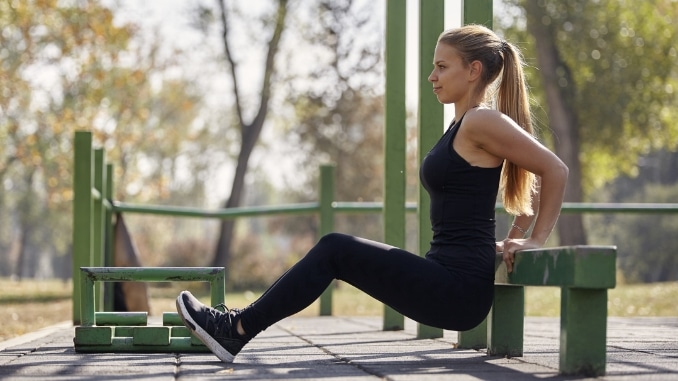Shoulder pain during dips can be a frustrating barrier to achieving your upper body strength goals. Whether you’re a seasoned gym-goer or just starting, knowing how to perform dips correctly is crucial.
In this article, we’ll explore the causes of shoulder pain [1], how to fix it, and whether dips are beneficial for your triceps.
How to Perform Dips: Step-by-Step Guide
- Start Position: Grip the edge of the bench firmly with your palms facing backward. Your arms should be straight and your shoulders down.
- Body Position: Keep your body upright or lean slightly forward, depending on your comfort. This helps target different muscles.
- Lower Down: Bend your elbows to lower your body. Keep your elbows close to your sides, aiming for a 90-degree angle at the elbow joint.
- Push Up: Engage your triceps and chest muscles to push back up to the starting position. Control the movement to avoid shoulder strain.
Proper Technique of the Dip

Performing dips with good [2] technique is vital for preventing injuries. A common mistake is leaning forward too far or allowing the shoulders to rise, which can lead to shoulder pain.
Focus on keeping your shoulder blades down and back throughout the movement. This stability helps support the shoulder joint and reduces compressive load on the rotator cuff tendons.
How to Fix Shoulder Pain from Dips
If you’re experiencing shoulder pain, consider the following tips:
- Rest and Recovery: Give your shoulders time to recover. Persistent pain may indicate an underlying issue.
- Strengthening Exercises: Incorporate shoulder mobility and strengthening exercises, like push-ups and overhead presses, to build stability.
- Adjust Technique: Pay attention to your form. Ensure your elbows aren’t flaring out and that you’re not overextending your shoulders.
- Consult a Physical Therapist: A professional can provide personalized exercises to target weakness and improve your range of motion.
According to Dr. Chad Wesley Smith, a strength coach and physical therapist. He emphasizes that shoulder pain during dips often results from improper shoulder mechanics. He advises lifters to focus on:
- Elbow Positioning: Keeping elbows tucked close to the body to minimize shoulder strain.
- Progression: Gradually increasing dip depth and load to allow shoulder adaptation.
- Strengthening: Incorporating shoulder stability exercises to support the joints during dips.
Are Dips Good for Triceps?
Absolutely! Dips primarily target the triceps brachii, particularly the long head. They also engage the pectoralis major [3] and shoulder girdle muscles, making them a compound movement that’s highly effective for building upper body strength.
However, improper technique can wreak havoc on your shoulders, so always prioritize good form.
Dip Pain: Common Causes
Shoulder pain during dips can stem from various factors:
- Weakness in Muscles: Insufficient strength in the shoulder or triceps may lead to improper movement patterns.
- Poor Mobility: Limited shoulder mobility can restrict movement, causing pain during shoulder flexion and extension.
- Injury: Previous injuries, particularly to the rotator cuff [4] or biceps tendon, can flare up during dips.
Conclusion
Incorporating weight dips into your workout can be beneficial, but it’s essential to perform them with good technique to avoid shoulder pain.
By understanding the common causes of discomfort and focusing on shoulder mobility and strength, you can enjoy the benefits of dips without the pain. Remember, if you experience ongoing issues, consulting with a physical therapist can provide invaluable support.
Stay strong, and don’t let shoulder pain hold you back from your fitness goals! Check out this Effective Rotator Cuff Exercises now!
Frequently Asked Questions
How do you do dips without hurting your shoulders?
- Form: Keep your elbows close to your body and avoid flaring them out.
- Range of Motion: Lower yourself only to a comfortable point; don’t go too deep.
- Warm-Up: Always warm up your shoulders before performing dips.
What is the most common injury from dips?
Shoulder Injuries: The most common injury is shoulder strain or tissue impingement due to poor form or overextension.
What are the disadvantages of dips exercise?
- Shoulder Stress: They can place significant stress on the shoulders.
- Risk of Injury: If performed incorrectly, there’s a higher risk of injury.
- Not Suitable for Everyone: Individuals with shoulder issues may find dips uncomfortable or painful.
Are dips better than pushups?
Depends on Goals: Dips target the triceps and lower chest more intensely, while pushups engage a broader range of muscles. Neither is universally better; it depends on your fitness goals.
How many dips a day is normal?
Typical Range: 5 to 15 dips per set, with 2 to 4 sets, depending on fitness level. Beginners should start with fewer reps.


